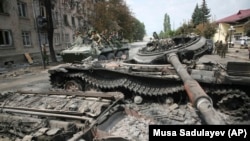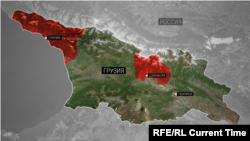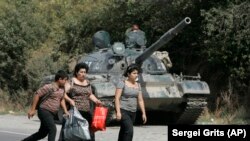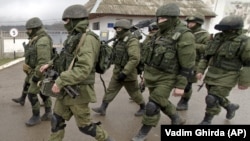August 7 marks the 10-year anniversary of what would come to be known as the Russo-Georgian War of 2008. The war began with an offensive by Georgian government forces toward the capital of South Ossetia, a separatist territory propped up by Russia since the early 1990’s. Over the next five days, Russia’s military responded, driving the Georgian military away from South Ossetia and Abkhazia (another Russian-backed separatist territory located on coast of the Black Sea), and invading Georgian government controlled territory north of the capital of Tbilisi before a ceasefire agreement was brokered.
To mark the anniversary of that short conflict, Andrey Kots wrote about how the war affected Russia’s military in an article for the state-run RIA Novosti. The basic thesis of Kots’ article –that the war exposed many deficiencies in the Russian armed forces, which would later be addressed in a huge modernization project – is essentially true. However, Kots seems to portray the Russian army as the underdog in the conflict when he writes about its material deficiencies compared to Georgia’s “high-tech” weaponry and NATO-standard training.
While it is true that Georgia received some weapons and equipment (such as M4 carbines and Humvee light-wheeled vehicles), as well as U.S. training up to NATO standards, given the vast difference in manpower and equipment between the two nations, the outcome of the war was never in doubt and the Georgians were always at a serious disadvantage.
A paper by Koba Liklikadze published by the Jamestown Foundation helps shed light on the disposition of forces in the region in August 2008. It notes that the Russian 58th army, which did most of the fighting during the conflict, had a strength of 70,000 men – twice the size of the entire Georgian armed forces. The 58th had also just completed a military exercise called Caucasus 2008, in which it trained to respond to a Georgian threat in South Ossetia. As such, it was well prepared for war.
The paper also points out that Georgia’s best troops were deployed in Iraq at the time, and they were unable to return until after the conflict had ended. An attempt to call up 10,000 reservists also failed.
A more thorough study by the Strategic Studies Institute summarizes the comparison between the two opponents:
“The Russian and Georgian performances in the war were in many ways mirror images of each other. Russian strategy was well-thought-out and properly resourced, giving Russia significant advantages at the operational level of war and allowing it to overcome shortcomings at the tactical level. The Georgian military, by contrast, was reasonably well-trained and well-equipped at the small-unit level and fought well in tactical engagements, but the reactive nature of Georgian strategic and operational planning and the often haphazard way in which plans were conceived and implemented undercut the tactical advantages the Georgians enjoyed, thus undermining their entire effort.”
As alluded to earlier, one thing Kots gets right is that the war exposed many shortcomings in the Russian armed forces, and this led to a major effort to reform and modernize Russia’s military. But, while bragging about that modernization’s success, the author makes an amusing admission.
“The world first saw Russia’s new army in late February 2014,” Kots writes.
“Grown men in ‘digital’ camouflage and balaclava masks appeared in the Crimea as if from out of nowhere and within a few days took control of the entire peninsula with an area of 27,000 square kilometers,” Kots continued.
This is interesting because at the time of the Crimean annexation, which Kots is clearly describing, President Vladimir Putin initially denied that Russian soldiers were occupying strategic locations around the peninsula. Despite being equipped with the latest Russian gear, all provided by the military modernization program, Putin claimed that the armed men seen deploying throughout Crimea were local “self-defense” units formed by local pro-Russian residents. He explained that the uniforms and equipment could be bought in any military surplus store.
While Putin would later admit that the so-called “Little Green Men” occupying Crimea were in fact Russian soldiers the whole time, since then the Kremlin has insisted that the “Crimean people” conducted a referendum to separate from Ukraine and join Russia on their own. In fact, this narrative has become an essential element of Vladimir Putin’s public speeches.
But here Kots lets the truth slip out. His words are a testimony, that it was a military annexation carried out by Russian soldiers in their new modern uniforms and equipment.








